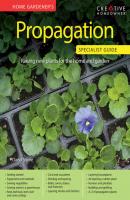Home Gardener's Propagation (UK Only). David Squire
Чтение книги онлайн.

Читать онлайн книгу Home Gardener's Propagation (UK Only) - David Squire страница 3
Название: Home Gardener's Propagation (UK Only)
Автор: David Squire
Издательство: Ingram
Жанр: Сад и Огород
isbn: 9781607652427
isbn:
Grafting and budding
These are more complicated methods of increasing plants, and are mainly performed on plants that do not come true from seeds and cannot be divided or layered. Budding involves uniting a bud of the desired variety with a rootstock of known and desired vigour. In grafting, a shoot with several buds is united with a desired rootstock (see pages 38–41).
Wildflower meadows often become a feast of colour from annuals; wildflower mixes are available from seed companies.
Plants for easy propagation
Where do I begin?
Many plants can be easily increased by home gardeners and a wide range of them are featured here. Most techniques for increasing plants do not need expensive and complicated equipment, and some methods, such as taking hardwood cuttings, require only a sheltered piece of ground. Layering a shrub is also straightforward and requires just a few simple tools, but rooting takes many months. Grafting and budding are more complex, but still possible.
SINGLE OR MANY PLANTS?
Some methods of increasing plants, such as by seed, produce many new plants, while layering a shrub or tree creates only one new plant for each branch that is layered. Budding and grafting also usually produce just one new plant, although several grafts are used when rejuvenating an old apple tree through methods such as crown grafting.
When new plants are produced from seed, there is a chance that a few of the progeny will differ from the parent plant. With all non-seed methods (cuttings, layers, division, grafts and budding), however, the ensuing plants will be identical to the parent. Softwood cuttings are the most popular type of cutting, used for many soft-stemmed plants.
Annuals
Plants that grow from seed, produce flowers and die within the same year. However, some plants that are normally raised as annuals are not true annuals.
A vibrantly coloured display
Biennials
Plants that are raised from seed, making initial growth one year and flowering in the following one. Some plants raised in this way are not strictly biennial.
Alcea rosea (Hollyhock)
Herbaceous perennials
Usually refers to hardy border plants that die down to ground level in autumn at the end of their growing season, then produce fresh growth in spring.
Medley of herbaceous plants
Roses
Woody and mainly deciduous plants with a permanent framework, regularly pruned to encourage healthier and better growth and the development of flowers.
Rosa ‘Paul’s Scarlet Climber’
Climbers
Known in North America as vines, climbing plants include a wide range of growing types, including annuals, woody plants and herbaceous perennials.
Vitis (Ornamental Vine)
Shrubs
Woody and perennial, with stems growing from soil level and with no trunk. However, through training, some plants can be grown either as a shrub or as a tree.
Ceanothus thyrsiflorus var. repens
Trees
Woody and perennial plants that have a clear trunk between ground level and the lowest branches. They can be evergreen or deciduous, depending on the species.
Amelanchier lamarckii
Soft fruits
These have varied habits, ranging from strawberries that grow at ground level to cane fruits such as raspberries, and bush fruits including gooseberries and black-, red- and whitecurrants.
Redcurrants
Fruit trees
Many fruits grow on trees, including apples, pears, plums, apricots, damsons, cherries, peaches, nectarines, mulberries and quinces.
Apple ‘Cox’
Vegetables
These vary both in their growing habits and in the ways in which they are propagated. Most are raised yearly from seed, while others are grown from tubers and a few from bulbs.
Range of lettuces
Culinary herbs
Herbs include a range of plant types: for example, Parsley is a hardy biennial raised as an annual; Sweet Bay is an evergreen shrub; and others are herbaceous perennials.
Herbs in pots